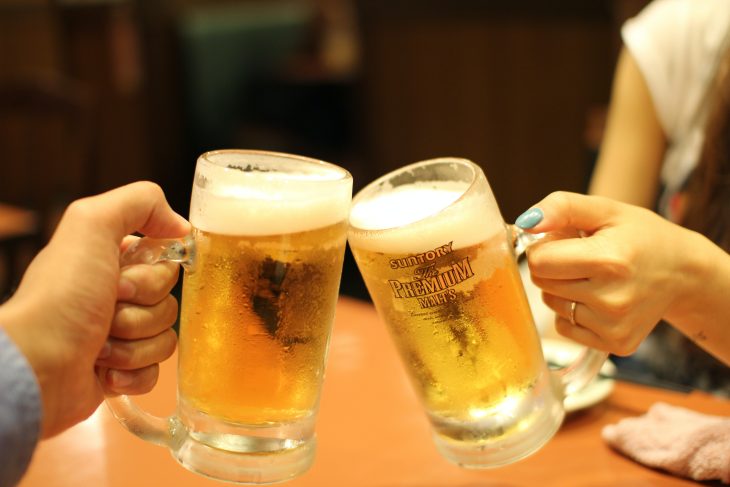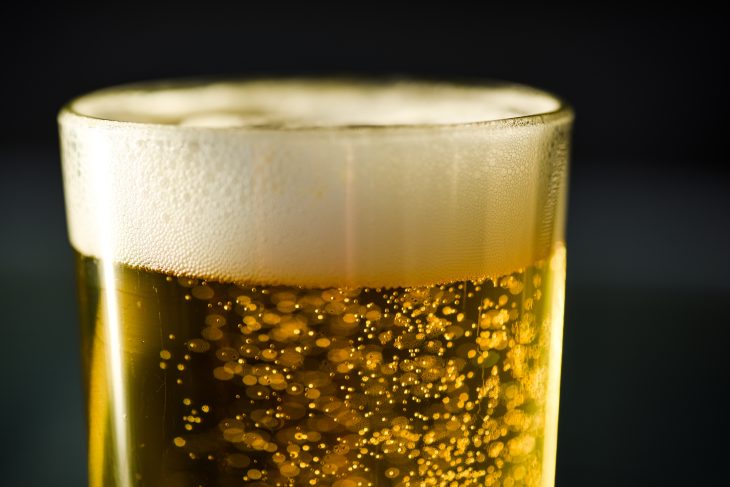Hey there! This site is reader-supported and we earn commissions if you purchase products from retailers after clicking on a link from our site.
Is beer just beer or can it be something more? The division between ales and lagers proves that, yes, beer has more than one identity. It has hundreds. Within the classification of ale vs lager, beer takes on many characteristics and qualities. How do you know which beer is which? The first step is to know the difference between ales and lagers, so let’s get started.
Table of Contents
- What is Beer?
- What’s an Ale?
- What is a Lager?
- Ale Beer vs Lager Beer: All the Differences
- Video Guide: Ale Beer vs Lager
- Common Misconceptions About Ale vs Lager
- Ale Beer vs Lager FAQs
What is Beer?
All things in this discussion begin and end with beer. Created by the fermentation of malted starches into alcohol and carbonation, beer is an alcoholic beverage that may contain hops. Keep in mind that hops are not necessary to make beer, though they do help preserve the beer and give it a touch of bitterness and aroma. Some beers even include spices, herbs, and fruit to add a unique blend of flavors that consumers love.
Beer is also historically known as “ale.”

What’s an Ale?
So is ale just beer then? The short and sweet answer is yes; but let’s not fool ourselves. An ale is more than a beer with bitter flavors from hops and a higher alcoholic content than a lager.
Different kinds of ales include:
- American Wheat Ale
- Hefeweizen
- India Pale Ale (IPA)
- Imperial or Double Pale Ale
- New England India Pale Ale (NEIPA)
- American Pale Ale (APA)
- West Coast India Pale Ale (WCIPA)
- Brown Ale
- Scotch Ale
- Porter
- Stout
- Russian Imperial Stout
- Sour Ales (Berliner Weisse, Lambics, Old Bruin, Flanders Red Ale, and more)
What is a Lager?
A lager is the opposite of an ale but not entirely. Lagers are also a kind of beer, but they are brewed differently than ales. The word “lager” comes from a German word meaning “to store.” Back when lagers were first brewed, the idea was that these beers would keep for longer than ales in the cool cellars of Bavarian households.
Due to the way lagers are brewed, they are much crisper, clearer, and smoother than ales.
Different kinds of lagers include:
- American Pale Lagers
- American Dark Lagers
- Bock
- Doppelbock
- Eisbock
- Maibock
- Dortmunder Export
- Oktoberfest Beer
- Munich Dunkel
- Munich Helles
- Schwarzbier
- Pilsner
- Vienna Lager
Ale Beer vs Lager Beer: All the Differences
Looking at some of the various styles of ale and lager beers around, you may be able to figure out the differences based on look and taste alone. If you’re a homebrewer, knowing what makes an ale not a lager will help you when it comes time to make a new recipe. Besides, you will come to appreciate what makes each style complex in its own way.
Brewing an Ale vs Lager
When all is said and done, it’s the method of brewing ales and lagers that separates them. So let’s take a look at that first.
Top Fermenting vs Bottom Fermenting Yeasts
The most distinguishable difference between ale beer vs lager beer is that ales are brewed with top-fermenting yeast. Lagers, on the other hand, require bottom-fermenting yeasts. Yet, the imagery these phrases tend to create isn’t entirely correct. One yeast doesn’t float while the other sinks.
Rather, a top-fermenting yeast will generate a thick layer of foam on top of the wort, which contributes to the krausen. Bottom-fermenting yeast doesn’t do that. It reacts more slowly than top-fermenting yeast.
Cool Fermentation vs Warm Fermentation
Another difference is the temperature at which ale and lager beers ferment. Traditionally, lager beers were designed to ferment at much cooler temperatures—around 42-55°F. Meanwhile, ale ferments with warmer temperatures, between 60-75°F.
Since fermentation takes longer when the temperature is lower, lagers tend to have a longer brew time than ales.
All About Lagering
As mentioned earlier, lagers were stored in cellars and caves in the past. In old Bavaria, brewers left the beer to ferment throughout the winter. In the spring, the beers were drinkable. Little has changed about the maturation process for lagers, though modern technology keeps them out of the cave and safe within the refrigerator.
Ales don’t need to be lagered—or stored—for a long period of time. They also don’t require cold storage during fermentation. This is also one of the reasons why a high quality lager tends to cost more than an ale!

Alcohol Content in Lager vs Ale
Yeast has a direct influence on how much alcohol a beer develops, so it doesn’t matter in the ale vs lager debate. How much yeast is dumped into the wort, and the amount of sugar present, leads to more or less alcohol. Furthermore, yeast will die around 104°F. At 58°F, it sporulates and goes dormant.
Ale, being that it is top-brewed, has yeast that works faster. Because of that, the yeast is also more hardy than bottom-fermenting yeast. Ales can have greater amounts of alcohol, because the yeast will survive for longer.
Bottom-fermenting yeast is a bit more fragile. Too much alcohol kills it off, so lagers tend to have a lower alcohol by volume (ABV) than ales.
What About the Ingredients and Hops?
For the most part, anything considered a beer is going to have the basic ingredients: grains, yeast, water, and for most styles, hops. For ales, hops tend to be more prominent, which is why Indian Pale Ales (IPAs) are a thing. However, that’s not to say that lagers aren’t brewed with hops.
Now here is an interesting tidbit for you. Because Germany had passed Purity Laws (the Reinheitsgebot) in 1516, lagers have remained the same for many years. Brewers have experimented to some degree with lagers, but many of them use the same recipes they have for centuries. In America, a vast amount of lagers are mass-produced, though they also tend to have the same characteristics of European lagers: smooth, crisp, and clean beer.
Ales never had such constraints, so there is a wider range and certain wild abandon that comes with crafting a drinkable ale. IPAs, stouts, and dozens of other ales exist.
Video Guide: Ale Beer vs Lager
Common Misconceptions About Ale vs Lager
By now, you should be aware that the main division between ale vs lager is the kind of yeast and fermentation used. Ales ferment at warmer temperatures and use top-fermenting yeast. Lagers are the opposite. This is the line by which all ales and lagers are judged.
However, there are plenty of misconceptions about the differences between ales and lagers on the internet that need to be tackled. After all, no one likes false information!
Lagers Are Always Pale
Yeast doesn’t affect the color of a beer. The malt does. Depending on whether a malt is dark or light roasted, your beer will be dark, brown, amber, or pale. Yes, many lagers are a pale yellow or gold. But take into the consideration Schwarzbier, which literally means “black beer.” It’s liquid darkness.
The misconception that all lagers are lighter than ales may have started with the fact that lagers are clearer than ales. Since the lager takes a longer time to ferment, there is much less haze.
Ales Are Tastier Than Lagers
Take a look at all the mass-produced, globally consumed beers. You will find that lagers are the style of beer people tend to drink more of. Sometimes, the amount of beer you consume has to do with how much you love the taste. Yet, when you consider just how many low quality lager beers exist in the world, like Budweiser, Qingdao, Snow, and Coors, it may be because those beers are weak.
However, those lagers aren’t aimed at people looking for a tasty beer. If a lager tastes bland, it’s the quality of the ingredients, not the style of beer. Therefore, if you purchase a slightly more expensive, high quality lager, you will find that the flavors can be as rich and bold as the juiciest Hazy IPA. Take, for instance, beers that are similar to Heineken, like Samuel Smith Organic Lager Beer.
Sample as many ales and lagers as you can. Beer comes in a rainbow of colors and flavors; you can’t judge on style based on what’s commercially brewed.
Lagers Always Have Low ABV
Again, while lagers do tend to have a lower amount of alcohol when compared to ales, this isn’t always the case. Both ales and lagers can be produced to have either low or high amounts of alcohol. It depends on the amount of malt in a recipe.
Ale, Lager—It’s All Beer to Me!
Beer is either an ale or a lager. There are differences between ale vs lager beers that you need to know, especially if you want to start homebrewing your own beers. In short, ales are often darker, cloudier, and more bitter than lagers, because of the way they are fermented. Lagers take longer to ferment and are stored at cooler temperatures, which leads them to be lighter and crispier. The main difference, though, is in the yeast!
Whether you love ales or lagers or find yourself in the gray zone in between, sampling everything, you’ll find that there is room for both ales and lagers in your life.
Ale Beer vs Lager FAQs
Yes and no. If you are referring to “ale” for beer, then yes, there is a difference. Both ales and lagers are two categories of beer. Traditional beer, or ale, is made with top fermenting yeast and then fermented at higher temperatures than lager beer. Also, lagers tend to be clearer when bottled than other kinds of beer.
A lager is a kind of beer that is brewed using bottom fermenting yeast. Stored at cooler temperatures, lagers take a long time to completely mature. Because of that, lagers tend to be clear, crisp, and refreshing, which is the opposite of many ales.
When comparing commercial lagers to other kinds of beer—namely ales—the answer would be no. While both ales and lagers can have low amounts of alcohol, lagers typically are the weaker style of beer. This is because of the yeast used and the temperature at which the beer is fermented. Bottom fermenting yeast is a little weaker and can’t tolerate a high amount of alcohol.
Budweiser is considered a lager. Most commercially produced beers, such as Heineken, Coors, Miller, and Corona are lagers.
Recommended Reading
What Are the Types of IPA?
If you’re asking yourself, “What are the types of IPA?” you’ve come to the right place. Learn more about different types of Indian Pale Ale.
Ale vs Lager – What’s The Difference?
As a drinker and lover of beer, there will come a time when you start differentiating between the types of beers out there. Want to learn more about ale vs lager?
Pilsner vs Lager – What’s The Difference Between Pilsner and Lager?
The main difference in Pilsner vs Lager is in the flavors. Hops tend to have more of a presence in pilsners than other forms of lagers, but all lagers have refreshing flavor.
Lager Temperature Control Tips For Homebrewing
Lager temperature control can be difficult if you have just started brewing out. Learn more in the article!
50/50 Rye Lager
Mead vs. Ale: The Differences Between Ale and Mead
Mead and ale are both unique drinks with their own brand of deliciousness. You can select from dozens of flavors between ale and mead, so you can satisfy your cravings for sweet or tangy or bitter.

